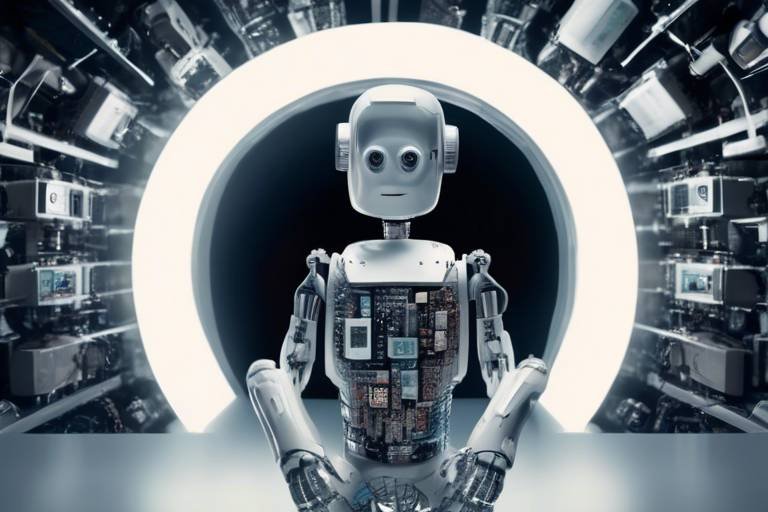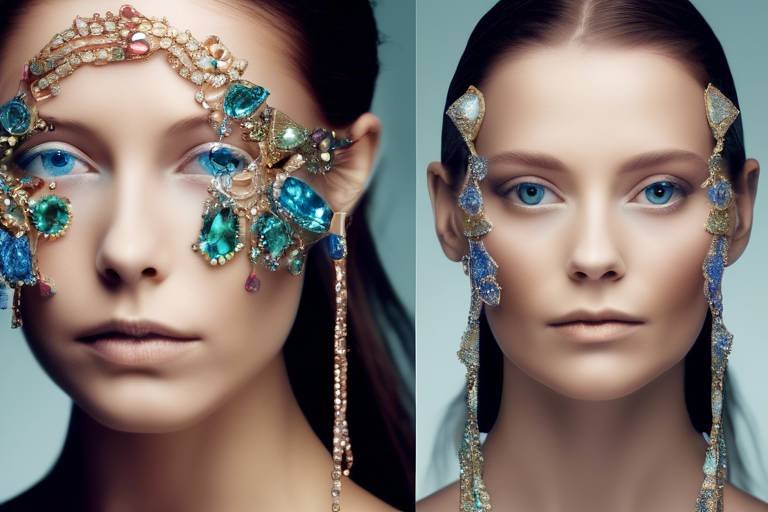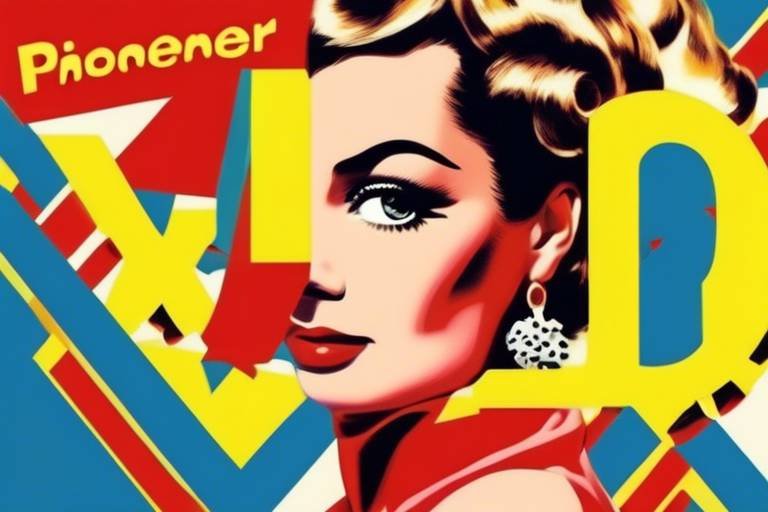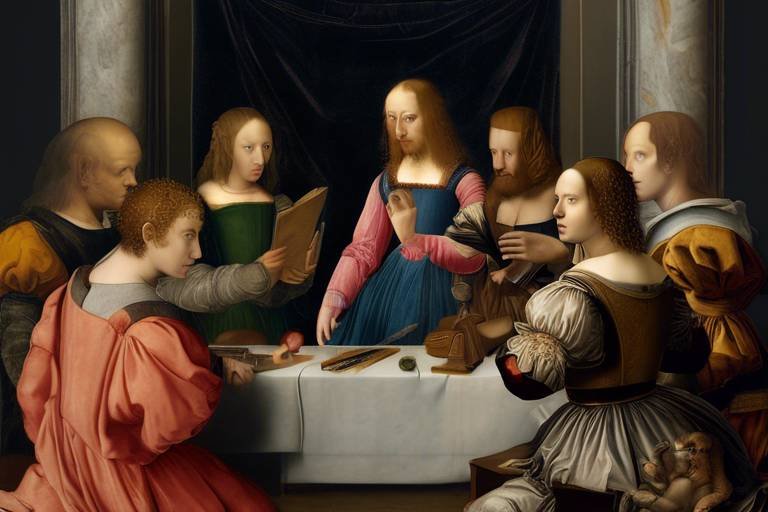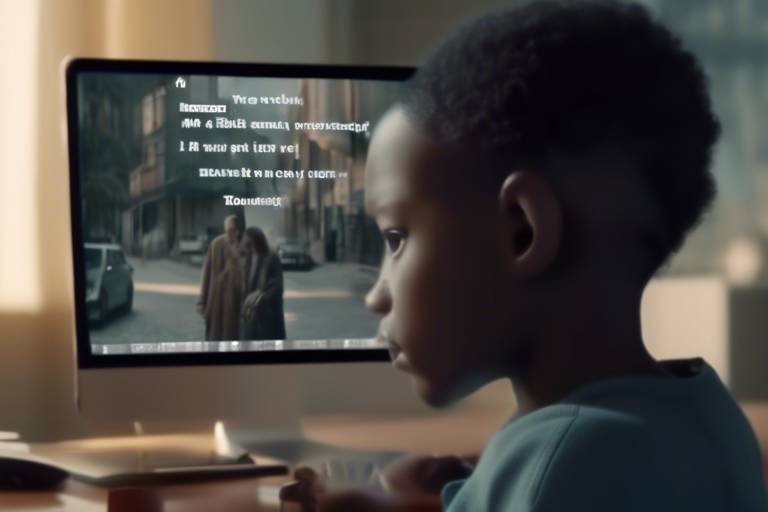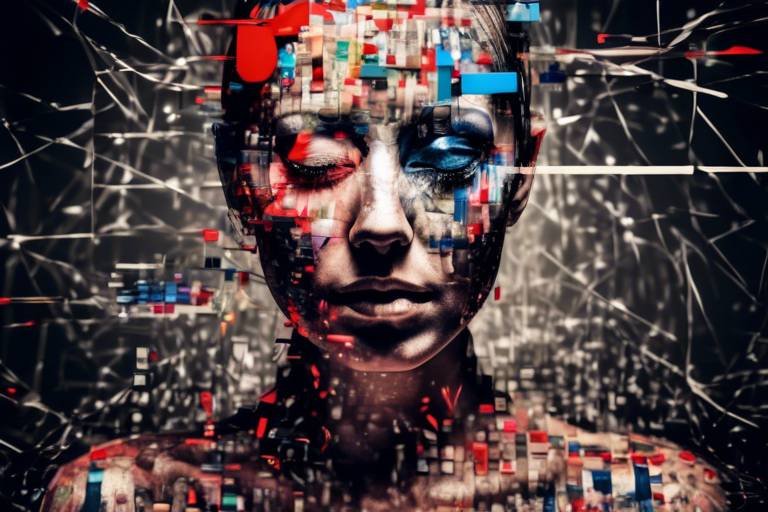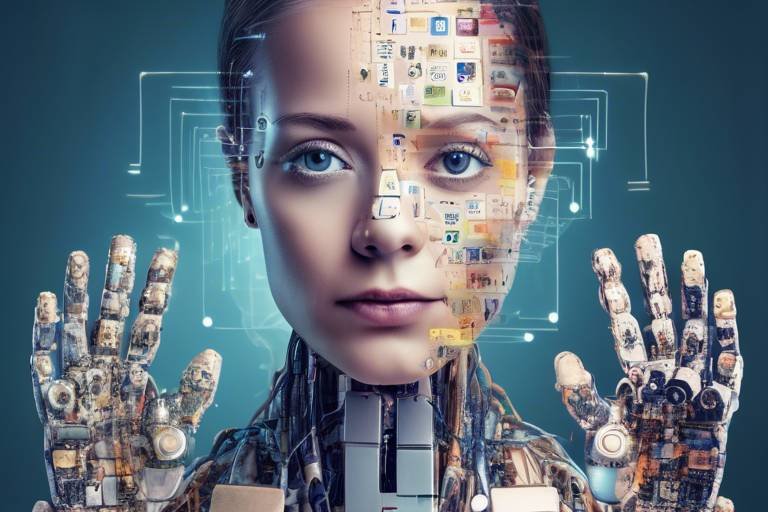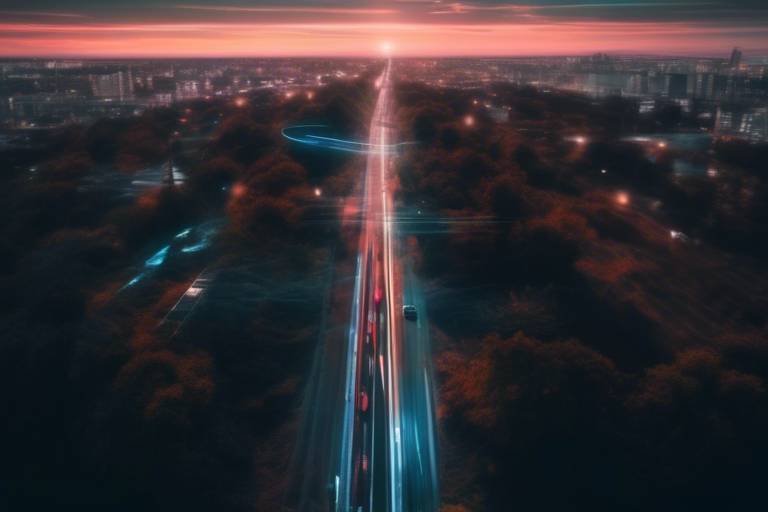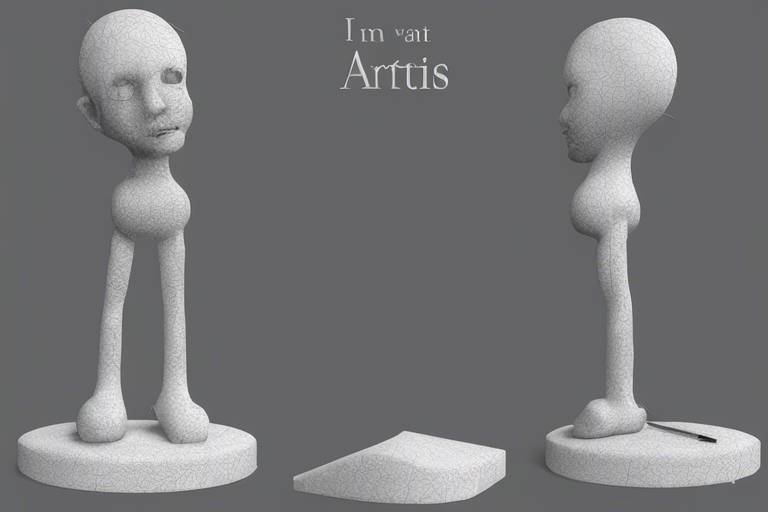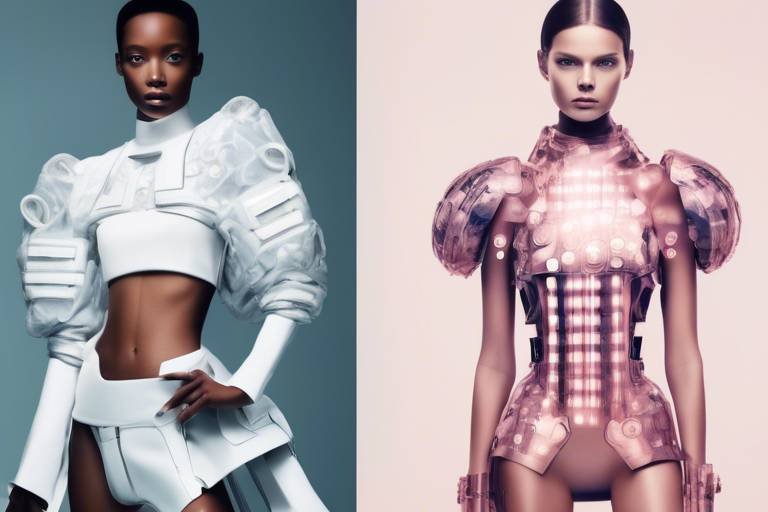AI's Influence on Creativity and Innovation
In today's fast-paced world, the intersection of artificial intelligence (AI) and creativity is not just a trend; it's a revolution. This article explores how AI is reshaping creative processes and fostering innovation across various industries, highlighting both opportunities and challenges presented by this technological evolution. Imagine a world where machines not only assist but actively participate in the creative journey, sparking ideas and pushing boundaries. It's like having a co-pilot in the cockpit of creativity, guiding us through uncharted territories. As we delve deeper into this fascinating topic, we will uncover how AI is not merely a tool but a transformative force that is redefining what it means to be creative.
AI is transforming traditional creative workflows by automating repetitive tasks, allowing artists and creators to focus on ideation and execution. Imagine a painter who spends hours mixing colors and preparing canvases, only to find that their best ideas come when they’re actually in the flow of painting. With AI handling the mundane, creators can dive straight into the heart of their work. This shift not only enhances the overall creative experience but also opens up a realm of possibilities that were previously unimaginable. By leveraging AI, artists can explore new dimensions of their craft, experiment with different styles, and ultimately produce more innovative works.
From graphic design to digital art, AI tools are enabling artists to experiment with new styles and techniques, pushing the boundaries of what is considered art and creativity. Think of AI as a creative partner that never tires and always offers fresh perspectives. These tools can analyze vast amounts of data, learning from thousands of artworks to suggest unique combinations of colors, shapes, and styles. The result? A new wave of art that challenges traditional notions of creativity. Artists can now create works that are not only visually stunning but also deeply innovative, exploring themes and ideas that resonate with contemporary audiences.
Generative art, created through algorithms, showcases how AI can produce unique pieces of art, challenging the notion of authorship and creativity in the digital age. This form of art is like a dance between human intention and machine learning, where the artist sets parameters and the AI fills in the gaps. It's a fascinating collaboration that raises questions about what it means to be an artist. Can a machine truly create art, or is it merely a reflection of human creativity? These questions are at the forefront of discussions about the future of art in an AI-driven world.
As AI-generated art becomes more prevalent, ethical considerations regarding originality, ownership, and copyright are emerging. Who owns a piece of art created by an algorithm? Is it the programmer, the user, or the AI itself? These questions are crucial as we navigate the complexities of creativity in the digital age. Discussions about the future of creative rights are essential to ensure that artists are protected while also embracing the innovations that AI brings to the table.
Collaborative tools that incorporate AI are empowering artists to enhance their work, providing suggestions and insights that can lead to innovative outcomes and new artistic directions. Imagine a musician who uses AI to analyze their previous compositions, gaining insights that inspire their next hit song. These tools act as catalysts for creativity, sparking new ideas and helping artists to break through creative blocks. The collaboration between human and machine is not just about efficiency; it's about unlocking new creative potentials.
AI's influence in music composition is revolutionizing how songs are created, offering musicians new ways to generate melodies, harmonies, and even lyrics, thus expanding creative possibilities. Picture a songwriter who, instead of staring at a blank page, has an AI that suggests chord progressions and lyrical themes based on current trends and historical data. This partnership allows musicians to explore uncharted musical territories, creating compositions that resonate with audiences in fresh and exciting ways.
Businesses are leveraging AI to drive innovation, streamline processes, and enhance customer experiences, ultimately leading to the development of new products and services that meet evolving market demands. It's as if AI is the secret ingredient in a recipe for success, transforming ordinary businesses into extraordinary ones. With the ability to analyze data at lightning speed, AI helps companies identify trends and opportunities that would otherwise go unnoticed. This proactive approach not only boosts creativity but also fosters a culture of innovation within organizations.
AI tools are transforming market research by analyzing consumer data more efficiently, enabling businesses to make informed decisions that foster innovation and creativity. Instead of relying solely on traditional surveys and focus groups, companies can now harness the power of AI to gain real-time insights into consumer behavior. This shift allows for a more dynamic approach to product development and marketing strategies, ensuring that businesses stay ahead of the curve.
Examining real-world examples of companies successfully integrating AI into their operations reveals the tangible benefits and innovative outcomes that can arise from embracing this technology. For instance, companies like Netflix and Spotify utilize AI algorithms to personalize user experiences, keeping customers engaged and satisfied. These case studies serve as a testament to the transformative power of AI, illustrating how it can drive creativity and innovation across various sectors.
- How is AI changing the creative industry? AI is automating repetitive tasks, allowing creators to focus on ideation and execution, thus enhancing the creative process.
- What is generative art? Generative art is created through algorithms, producing unique pieces that challenge traditional notions of authorship.
- Are there ethical concerns with AI-generated art? Yes, questions regarding originality, ownership, and copyright are significant as AI-generated art becomes more common.
- How can businesses benefit from AI? AI helps businesses streamline processes, enhance customer experiences, and drive innovation by analyzing data efficiently.

The Role of AI in Creative Processes
Artificial Intelligence is not just a buzzword; it’s a game-changer in the realm of creativity. Imagine a world where artists, writers, and designers are free from the mundane, repetitive tasks that often bog down their creative flow. AI is stepping in as a powerful ally, automating these tedious chores and allowing creatives to focus on what truly matters: ideation and execution. This shift doesn’t just enhance productivity; it enriches the overall creative experience, leading to innovative outcomes that were previously unimaginable.
Take graphic designers, for example. With AI tools at their fingertips, they can generate design variations in seconds, exploring a multitude of styles and color palettes without the painstaking manual effort. This newfound efficiency opens the door to experimentation and exploration, enabling designers to push the boundaries of their craft. It’s as if they have a co-pilot guiding them through the creative skies, suggesting new routes and landscapes to explore.
Moreover, AI can analyze trends and consumer preferences in real-time, offering insights that can spark fresh ideas. Imagine a writer who, instead of spending hours brainstorming, can input a few keywords and receive a plethora of suggestions for themes, plots, or character arcs. This not only saves time but also fuels creativity by introducing unexpected elements that a human might not have considered. It’s like having a brainstorming partner who never runs out of ideas!
However, while the benefits are clear, it’s essential to recognize the challenges that come with this integration. As AI takes on more creative responsibilities, questions arise about authorship and originality. Who is the true creator of a piece of art or music generated with the help of AI? Is it the artist who provided the initial concept, or the algorithm that executed it? These questions are not just philosophical; they have real implications for copyright laws and the future of creative rights.
In summary, the role of AI in creative processes is multifaceted. It acts as a catalyst for innovation, freeing creatives from the shackles of repetitive tasks while also presenting new ethical dilemmas. As we navigate this evolving landscape, one thing is certain: the collaboration between human creativity and artificial intelligence is just beginning, and the possibilities are as vast as our imaginations.

AI-Enhanced Design and Art
In the ever-evolving landscape of creativity, are emerging as powerful catalysts for innovation. Artists and designers are no longer confined to traditional methods; instead, they are embracing technology that allows them to push boundaries and explore new horizons. Imagine a world where your artistic vision can be realized in a fraction of the time it once took, where inspiration is just a click away, and where collaboration with an AI partner can lead to groundbreaking creations. This is not a distant future; it is happening right now.
AI tools are transforming the way we think about creativity. By automating mundane tasks such as color matching, layout adjustments, and even basic sketching, artists can focus more on what truly matters: their imagination. This shift not only enhances productivity but also opens the door to experimentation. With AI, artists can generate countless variations of their work, allowing them to discover unexpected styles and techniques that they might not have considered otherwise. For instance, an artist can input a simple concept and let the AI generate multiple iterations, each with its own unique flair. This process can lead to a more enriching creative experience, where the artist is both the creator and the curator of their own work.
One of the most fascinating aspects of AI in art is generative art. This form of art is created through algorithms that generate unique pieces based on a set of rules defined by the artist. It's like giving birth to a digital child that can evolve and adapt based on its environment. The implications of this are profound: as AI creates art, it challenges our traditional notions of authorship and creativity. Who is the true artist—the human who programmed the AI, or the AI itself? This question sparks vibrant discussions about the nature of creativity in the digital age.
As AI-generated art becomes more prevalent, we must grapple with a host of ethical considerations. Issues surrounding originality, ownership, and copyright are at the forefront of this discussion. For example, if an AI creates a piece of art that resembles the style of a famous artist, who owns the rights to that piece? Is it the programmer, the AI, or the original artist? These questions are not just theoretical; they have real-world implications for artists, businesses, and the art market at large. As we navigate this new terrain, it’s crucial to establish guidelines that protect the rights of all parties involved.
Moreover, collaborative AI tools are empowering artists to enhance their work in unprecedented ways. These tools can offer suggestions, provide insights, and even analyze trends to help artists stay ahead of the curve. For instance, platforms like RunwayML and DeepArt allow artists to experiment with different styles and techniques, transforming their creative process into a more dynamic and interactive experience. Imagine an artist who is stuck on a project; with the help of AI, they can receive real-time feedback and suggestions that can lead to innovative outcomes and new artistic directions. This collaboration between human creativity and machine intelligence is not only exciting but also essential for the future of art.
In conclusion, AI is not just a tool; it is a partner in the creative process. As artists and designers embrace these technologies, they are not only enhancing their own work but also redefining what it means to be creative in the modern world. The fusion of human ingenuity and AI capabilities is paving the way for a new era of artistic expression, where the possibilities are as limitless as the imagination itself.
- What is generative art? Generative art is a form of art created using algorithms, allowing for unique pieces to be produced based on specific rules set by the artist.
- Who owns AI-generated art? Ownership of AI-generated art is a complex issue and can depend on various factors, including the input provided by the artist and the capabilities of the AI.
- How can AI tools enhance the creative process? AI tools can automate repetitive tasks, provide suggestions, and analyze trends, allowing artists to focus on ideation and innovation.
- Are there ethical concerns with AI in art? Yes, there are ethical considerations regarding originality, ownership, and copyright that need to be addressed as AI-generated art becomes more prevalent.

Generative Art and Algorithms
Generative art is a fascinating intersection of technology and creativity, where algorithms play a pivotal role in the creation of unique visual experiences. Unlike traditional art forms that rely heavily on the artist's hand and intuition, generative art utilizes computer algorithms to produce stunning visuals, often in ways that are unexpected and surprising. Imagine a painter who, instead of wielding a brush, writes a set of instructions for a computer to follow, resulting in a piece of art that evolves and changes based on the data fed into it. This is the essence of generative art.
One of the most exciting aspects of generative art is its ability to challenge our perceptions of authorship and creativity. If a machine can create art, what does that mean for the artist? Are they still the creator, or does the algorithm take on that role? This question leads to a broader discussion about the nature of creativity itself. Is creativity merely the act of combining existing ideas in new ways, or is it something uniquely human? Generative art pushes the boundaries of these concepts, inviting us to rethink what it means to be an artist in the digital age.
To illustrate the process, consider the following components that are typically involved in generative art creation:
- Input Data: Artists often use various data sources, such as images, music, or even real-time environmental data, to inform the algorithm.
- Algorithm Design: The artist writes code that dictates how the data will be processed and transformed into visual elements.
- Output: The final piece can be static or dynamic, sometimes even interactive, allowing viewers to engage with the art in real-time.
As technology continues to evolve, so does the potential for generative art. Artists are now experimenting with machine learning techniques, enabling algorithms to learn from vast datasets and produce art that reflects complex patterns and styles. This not only expands the creative possibilities but also raises questions about originality. If an algorithm learns from existing artworks, can it truly create something new? Or is it merely remixing what has come before?
Moreover, the rise of generative art has sparked a new wave of discussions surrounding ethics and copyright. As AI-generated pieces flood the market, the question of ownership becomes increasingly complex. Who owns a piece of generative art—the artist who programmed the algorithm, the machine that created it, or the data that informed it? These questions are not just academic; they have real-world implications for artists, collectors, and the art market as a whole.
In conclusion, generative art and algorithms are reshaping the landscape of creativity, offering both exciting opportunities and challenging dilemmas. As we embrace this fusion of art and technology, it is essential to navigate the ethical landscape thoughtfully while celebrating the innovative possibilities that generative art presents.
Q1: What is generative art?
Generative art is a form of art that is created through algorithms and computer programs, allowing for unique pieces to emerge based on data input and algorithmic processes.
Q2: How does generative art challenge traditional notions of creativity?
It challenges traditional notions by questioning authorship and the role of the artist, as the creation is driven by algorithms rather than solely human intuition.
Q3: What are some ethical considerations surrounding generative art?
Ethical considerations include questions of originality, ownership, and copyright, particularly as AI-generated art becomes more prevalent in the market.
Q4: Can generative art be interactive?
Yes, generative art can be interactive, allowing viewers to engage with the artwork in real-time, often changing the output based on their actions.

Ethics in AI Art Creation
As we delve into the world of AI-generated art, ethical considerations are becoming increasingly significant. With the rise of algorithms capable of producing stunning visual pieces, we are faced with profound questions about originality, ownership, and the very essence of creativity itself. Who owns a piece of art created by a machine? Is it the programmer who designed the algorithm, the artist who provided the initial input, or the AI itself? These questions challenge our traditional understanding of authorship and provoke discussions about the future of creative rights.
One of the primary ethical dilemmas revolves around originality. AI systems often learn from vast datasets of existing artworks, which raises concerns about plagiarism and copyright infringement. If an AI generates a piece that closely resembles a human-created artwork, who is responsible? This situation has led to calls for clearer guidelines and regulations in the realm of AI art creation. Some argue that AI should be treated as a tool that enhances human creativity, while others believe it could potentially undermine the value of human-made art.
Furthermore, the question of ownership adds another layer of complexity. In many jurisdictions, copyright law is designed to protect the rights of human creators. However, as AI continues to evolve and create independently, the legal frameworks struggle to keep pace. This has prompted discussions about the need for new laws that address the nuances of AI-generated content. Should AI-generated works be eligible for copyright protection? If so, to whom would those rights belong?
Moreover, the implications of AI art extend beyond legal concerns; they also touch on the moral responsibilities of artists and technologists. As creators, we must consider the impact of our work on society and the potential for AI to perpetuate biases present in training datasets. The art world must engage in a dialogue about ethical practices in AI art creation, ensuring that the technology is used responsibly and inclusively.
To navigate these challenges, it is essential for artists, technologists, and policymakers to collaborate. A set of ethical guidelines could help frame the conversation around AI in art. Here are some key points that could be included in such guidelines:
- Transparency about the use of AI in the creative process.
- Clear attribution of contributions from human artists and AI systems.
- Consideration of the potential biases in AI training data.
- Encouragement of collaboration between human artists and AI technologies.
As we continue to explore the intersection of AI and creativity, it’s vital that we address these ethical questions head-on. The future of AI art creation is not just about technology; it’s about understanding our values as a society and how we want to define creativity in an increasingly automated world.
Q1: Can AI-generated art be copyrighted?
A1: Currently, copyright laws vary by jurisdiction, and many do not recognize AI as a creator. This is an evolving area of law, and discussions are ongoing.
Q2: Who is responsible for AI-generated art?
A2: Responsibility can fall on several parties, including the programmer, the user of the AI, or the organization that owns the AI. It depends on the specific circumstances of the creation.
Q3: How can biases in AI art be addressed?
A3: By ensuring diverse and representative datasets are used for training AI models, we can mitigate the risk of perpetuating existing biases in AI-generated art.
Q4: What is the future of AI in the art world?
A4: The future will likely see greater collaboration between human artists and AI, leading to innovative forms of expression while also necessitating ongoing discussions about ethics and ownership.

Collaborative AI Tools for Artists
In the ever-evolving landscape of creativity, collaborative AI tools are emerging as game-changers for artists across various mediums. These innovative platforms are designed to work alongside human creators, providing them with insights, suggestions, and even inspiration that can lead to groundbreaking artistic expressions. Imagine having a creative partner who never tires, always offers fresh perspectives, and is equipped with vast knowledge from countless artistic styles and techniques. This is precisely what AI brings to the table.
One of the most exciting aspects of these AI tools is their ability to analyze existing works of art and generate new ideas based on that analysis. For example, platforms like DeepArt and RunwayML allow artists to upload their creations and then apply various styles or modify elements in real-time. This not only saves time but also opens up a world of possibilities for artistic exploration. Instead of spending hours tweaking a piece, artists can experiment with different styles and techniques in a matter of minutes, thus enhancing their workflow.
Moreover, these tools often utilize machine learning algorithms that adapt to the artist's unique style over time. The more an artist interacts with the AI, the better it becomes at understanding their preferences and creative goals. This dynamic relationship fosters a sense of collaboration that can lead to unexpected and innovative outcomes. It's like having a personal assistant who knows your tastes so well that they can suggest ideas you never even considered!
However, while these tools offer immense potential, they also raise important questions about the nature of creativity and authorship. When an artist relies heavily on AI-generated suggestions, to what extent can they claim ownership of the final piece? This ongoing dialogue emphasizes the need for artists to maintain a balance between leveraging technology and preserving their personal touch.
In addition, many collaborative AI tools are designed to facilitate community interaction among artists. Platforms such as Artbreeder allow users to blend their artworks with those of others, creating a shared canvas for creativity. This not only fosters a sense of community but also encourages artists to learn from each other, pushing the boundaries of what is possible in art.
As we look to the future, it’s clear that collaborative AI tools will continue to evolve, offering even more advanced features and capabilities. Artists who embrace these technologies will likely find themselves at the forefront of a new artistic revolution, where creativity and innovation know no bounds. The key lies in using these tools to enhance, rather than replace, the human touch that is essential to the artistic process.
- What are collaborative AI tools for artists? Collaborative AI tools are software applications that work alongside artists to enhance their creative process by providing suggestions, insights, and inspiration based on data analysis.
- How do these tools improve the creative workflow? They automate repetitive tasks, analyze existing works, and generate new ideas, allowing artists to focus more on ideation and execution.
- Can AI tools replace human creativity? No, AI tools are designed to augment human creativity, not replace it. They can provide new perspectives but the essence of creativity remains a uniquely human trait.
- Are there ethical concerns with using AI in art? Yes, there are ongoing discussions about originality, ownership, and the implications of AI-generated art on traditional concepts of authorship.

AI in Music Composition
Have you ever wondered how technology can reshape the very essence of music? Well, AI is doing just that. The world of music composition is witnessing a revolutionary transformation, thanks to the integration of artificial intelligence. Imagine a scenario where musicians can effortlessly generate melodies, harmonies, and even lyrics without being confined to traditional methods. It's like having a creative partner that never runs out of ideas!
AI-powered tools are emerging as game-changers in this space, allowing artists to explore new creative avenues. For instance, algorithms can analyze vast amounts of musical data, identifying patterns and trends that human composers might overlook. This means that songwriters can now tap into a wellspring of inspiration, drawing from a diverse range of styles and genres. Think of it as having a musical encyclopedia at your fingertips, where every note and rhythm is just a click away.
One of the most exciting aspects of AI in music composition is its ability to generate original compositions. Tools like OpenAI's MuseNet and Google's Magenta are capable of creating music that ranges from classical to contemporary, showcasing the vast potential of AI. These systems use deep learning to understand the intricacies of music theory and composition, allowing them to produce pieces that can stand alongside human-created works.
However, this technological advancement does raise some questions. For instance, what does it mean for the future of music? Will AI composers replace human musicians, or will they merely serve as tools to enhance creativity? The truth is, AI can be seen as an extension of the artist's toolkit, providing new ways to experiment and innovate. Just like a painter uses brushes and colors, musicians can now use AI to explore uncharted territories in their compositions.
To illustrate the impact of AI on music composition, consider the following table that highlights some of the prominent AI music tools available today:
| AI Tool | Description | Key Features |
|---|---|---|
| MuseNet | Generates music across various genres and styles. | Multi-genre support, long compositions, and style blending. |
| Magenta | A research project by Google exploring machine learning in music. | Interactive tools, music generation, and collaboration features. |
| Amper Music | AI music composition tool designed for content creators. | Customizable music tracks, royalty-free usage, and easy integration. |
As we delve deeper into the realm of AI in music, it's essential to consider the implications of these innovations. While AI can assist in generating ideas and compositions, the human touch remains irreplaceable. The emotional depth, personal experiences, and unique perspectives that artists bring to their work cannot be replicated by machines. Thus, rather than viewing AI as a rival, it should be embraced as a collaborator that enhances the creative process.
In conclusion, AI is reshaping the landscape of music composition in profound ways. By providing tools that empower musicians to push their creative boundaries, AI is not just changing how music is made; it's expanding the very definition of what music can be. So, whether you're a seasoned composer or an aspiring artist, the future of music is bright, and AI is here to illuminate the path ahead!
- Can AI compose music that is as good as human composers?
While AI can generate impressive compositions, the emotional depth and personal touch of human composers are still unmatched.
- What are some popular AI music tools?
Some popular AI music tools include MuseNet, Magenta, and Amper Music, each offering unique features for music creation.
- Will AI replace human musicians?
AI is not likely to replace musicians but rather serve as a tool to enhance their creativity and expand their musical horizons.

Innovation in Business through AI
Artificial Intelligence (AI) is no longer just a futuristic concept; it's a powerful tool that is reshaping the business landscape. Companies across various sectors are harnessing the potential of AI to drive innovation, streamline operations, and enhance customer experiences. Imagine a world where businesses can predict consumer behavior with astounding accuracy or optimize their supply chains in real-time. This is not science fiction; this is the reality that AI is creating.
One of the most significant impacts of AI in business is its ability to analyze vast amounts of data quickly and efficiently. Traditional methods of market research can be slow and cumbersome, often leading to outdated insights. However, AI-driven market research tools can sift through consumer data at lightning speed, uncovering trends and patterns that human analysts might miss. This allows businesses to make informed decisions that are not only timely but also tailored to the evolving needs of their customers.
Furthermore, AI is enhancing creativity in product development. By utilizing AI algorithms, companies can simulate various design options and test them against consumer preferences. This iterative process can lead to innovative products that resonate with the target audience. For example, a fashion brand might use AI to analyze current trends and predict future styles, enabling them to stay ahead of the competition. The integration of AI into product design is akin to having a crystal ball that provides insights into what consumers will want tomorrow.
Moreover, AI is revolutionizing customer service. Chatbots and virtual assistants powered by AI can handle inquiries 24/7, providing instant support and freeing up human agents to tackle more complex issues. This not only improves customer satisfaction but also reduces operational costs. Imagine walking into a store and having an AI assistant greet you, understand your preferences, and guide you to products that match your style. This personalized shopping experience can significantly enhance customer loyalty.
To illustrate the impact of AI on business innovation, let’s take a look at a few case studies:
| Company | AI Application | Outcome |
|---|---|---|
| Netflix | Content recommendation algorithm | Increased viewer engagement and retention |
| Amazon | Predictive analytics for inventory management | Reduced operational costs and improved delivery times |
| Spotify | AI-driven music recommendation | Enhanced user experience and personalized playlists |
As businesses continue to embrace AI, they are not only improving their operational efficiencies but also unlocking new revenue streams. The ability to innovate rapidly in response to market demands is becoming a crucial competitive advantage. Companies that fail to adapt may find themselves left behind in this fast-paced digital age.
In conclusion, AI is a game-changer for businesses looking to innovate and grow. By leveraging AI technologies, companies can enhance their decision-making processes, improve customer interactions, and create products that truly resonate with their audience. The future of business is undoubtedly intertwined with AI, and those who embrace it will lead the way into a new era of innovation.
- How can AI improve customer service?
AI can provide 24/7 support through chatbots, handle inquiries instantly, and offer personalized recommendations based on customer preferences. - What are the benefits of AI-driven market research?
AI can analyze large datasets quickly, uncover trends, and provide insights that help businesses make informed decisions in real-time. - Can AI help in product development?
Yes, AI can simulate design options and test them against consumer preferences, leading to innovative products that meet market demands.

AI-Driven Market Research
In today’s fast-paced business landscape, is revolutionizing the way companies understand consumer behavior and market trends. Traditional market research methods often involve tedious data collection and analysis, consuming valuable time and resources. However, with the advent of artificial intelligence, businesses can now leverage advanced algorithms to sift through vast amounts of data in a fraction of the time it would take a human analyst. This not only enhances efficiency but also provides deeper insights into consumer preferences and market dynamics.
Imagine having a tool that can analyze millions of consumer interactions across various platforms—social media, e-commerce, and customer reviews. AI systems can process this data to identify patterns and trends that would be nearly impossible for a human to discern. For instance, AI can detect shifts in consumer sentiment in real-time, allowing businesses to pivot their strategies swiftly. This agility is crucial in a world where consumer preferences can change overnight.
Moreover, AI-driven market research tools can segment audiences with remarkable precision. By analyzing demographic data, purchasing behavior, and even psychographic factors, businesses can create highly targeted marketing campaigns that resonate with specific consumer segments. This level of personalization not only enhances customer engagement but also maximizes return on investment (ROI) for marketing efforts.
To illustrate the impact of AI on market research, consider the following table that highlights key advantages:
| Advantage | Description |
|---|---|
| Speed | AI processes data at lightning speed, offering insights almost instantly. |
| Accuracy | Advanced algorithms minimize human error, providing more reliable data analysis. |
| Cost-Effectiveness | Automating research reduces the need for large teams, saving costs. |
| Predictive Analytics | AI can forecast future trends based on historical data, aiding strategic planning. |
However, while the benefits of AI-driven market research are compelling, it’s essential to approach this technology with a critical eye. Ethical considerations surrounding data privacy and the potential for bias in AI algorithms must not be overlooked. Companies must ensure that they are not only compliant with regulations but also transparent in their data usage practices. After all, trust is a currency in the digital age, and maintaining consumer confidence is paramount.
In conclusion, as businesses increasingly adopt AI-driven market research tools, they stand to gain a significant competitive edge. By harnessing the power of AI, companies can make informed decisions that foster innovation and creativity, ultimately leading to products and services that better meet the needs of their customers. The future of market research is here, and it’s powered by artificial intelligence.
- What is AI-driven market research?
AI-driven market research refers to the use of artificial intelligence technologies to analyze consumer data and market trends, enabling businesses to make informed decisions quickly and efficiently. - How does AI improve market research accuracy?
AI minimizes human error by utilizing advanced algorithms that analyze data more reliably, providing insights that are more accurate than traditional methods. - Are there ethical concerns with AI in market research?
Yes, ethical concerns include data privacy, potential biases in algorithms, and the need for transparency in data usage to maintain consumer trust. - Can AI predict future market trends?
Absolutely! AI can analyze historical data to forecast future trends, helping businesses to strategize effectively.

Case Studies of AI in Business
When we talk about AI in business, the conversation often shifts to real-world applications that have not only transformed operations but also redefined entire industries. Let's dive into a few inspiring case studies that illustrate how companies are leveraging AI to drive innovation and enhance their competitive edge.
One of the most notable examples is Netflix. The streaming giant utilizes AI algorithms to analyze viewer preferences, which helps in personalizing recommendations for its users. This not only enhances user experience but also significantly increases viewer engagement. By analyzing data on viewing habits, Netflix can predict what shows or movies will be popular, allowing them to invest wisely in original content. This data-driven approach has led to the creation of blockbuster series like "Stranger Things" and "The Crown," proving that AI can be a game-changer in content creation.
Another impressive case is that of Amazon, which has integrated AI into its logistics and customer service. Through AI-driven algorithms, Amazon optimizes its supply chain management, predicting inventory needs and reducing delivery times. Moreover, their AI chatbot, Alexa, offers personalized shopping experiences and assists customers with queries in real-time. This level of automation not only streamlines operations but also enhances customer satisfaction, showcasing how AI can revolutionize e-commerce.
In the automotive industry, Tesla stands out for its innovative use of AI in self-driving technology. Tesla’s vehicles are equipped with advanced AI systems that analyze vast amounts of data from sensors and cameras, enabling them to make real-time decisions on the road. This technology not only enhances safety but also paves the way for the future of autonomous vehicles, illustrating how AI can disrupt traditional transportation models.
Furthermore, in the healthcare sector, IBM Watson has made significant strides by harnessing AI to improve patient care. Watson can analyze medical literature and patient data to assist doctors in diagnosing diseases and recommending treatment plans. This capability not only speeds up the decision-making process but also enhances the accuracy of diagnoses, ultimately leading to better patient outcomes. It’s a prime example of how AI can bring about innovation in critical sectors that directly affect human lives.
To summarize, these case studies highlight the transformative impact of AI across various industries. Whether it's enhancing customer experiences, optimizing operations, or driving innovation, AI is proving to be an invaluable asset for businesses aiming to thrive in today's competitive landscape. The future looks promising as more companies embrace this technology, paving the way for even more groundbreaking advancements.
- What industries are most affected by AI? AI is impacting a wide range of industries, including entertainment, e-commerce, automotive, and healthcare.
- How does AI improve customer experience? By analyzing data, AI personalizes interactions and offers tailored recommendations, enhancing user satisfaction.
- Are there ethical concerns regarding AI in business? Yes, issues related to data privacy, job displacement, and algorithmic bias are significant concerns that businesses must address.
Frequently Asked Questions
- How is AI influencing creativity in the arts?
AI is revolutionizing the arts by automating mundane tasks, which allows artists to concentrate on the more imaginative aspects of their work. This shift not only enhances the creative process but also opens up new avenues for artistic exploration.
- What is generative art, and how does AI contribute to it?
Generative art refers to artwork created using algorithms and AI. These technologies can produce unique pieces that challenge traditional notions of authorship and creativity, showcasing how machines can contribute to the artistic landscape.
- Are there ethical concerns regarding AI-generated art?
Yes, as AI-generated art becomes more common, ethical issues surrounding originality, ownership, and copyright are increasingly coming to the forefront. These discussions are crucial for defining the future of creative rights in the digital age.
- How can AI tools enhance the work of artists?
Collaborative AI tools provide artists with insights and suggestions that can inspire new directions in their work. By integrating AI into their creative processes, artists can explore innovative outcomes that they might not have considered otherwise.
- What role does AI play in music composition?
AI is transforming music composition by offering musicians new methods to generate melodies, harmonies, and even lyrics. This technology expands the creative possibilities, allowing artists to explore sounds and styles that may have been previously unattainable.
- How is AI impacting innovation in businesses?
Businesses are leveraging AI to drive innovation by streamlining processes and enhancing customer experiences. This not only leads to the development of new products and services but also helps companies adapt to the ever-changing market demands.
- What advantages does AI-driven market research offer?
AI tools can analyze consumer data more efficiently than traditional methods, enabling businesses to make informed decisions that foster innovation. This capability allows companies to better understand their customers and adapt their strategies accordingly.
- Can you provide examples of companies successfully using AI?
Many companies have successfully integrated AI into their operations, resulting in tangible benefits. These case studies illustrate how embracing AI can lead to innovative outcomes and improved efficiency across various industries.

